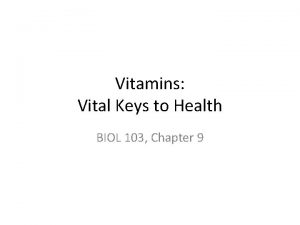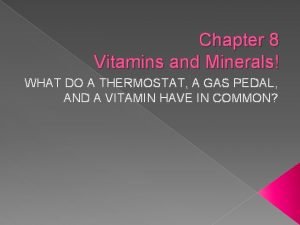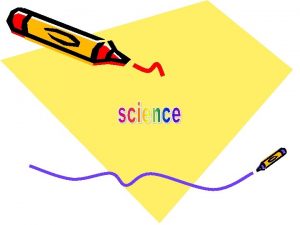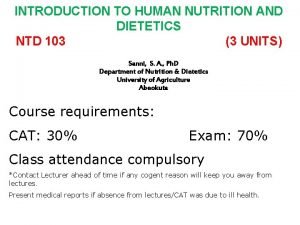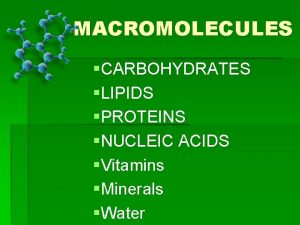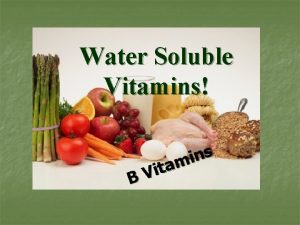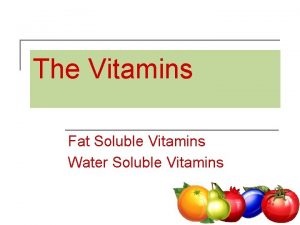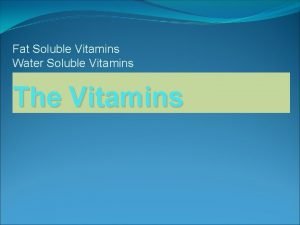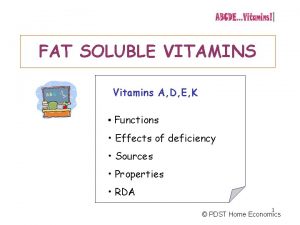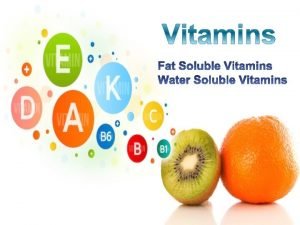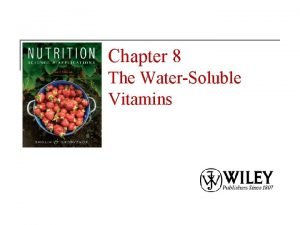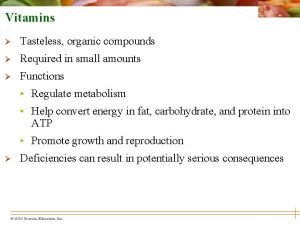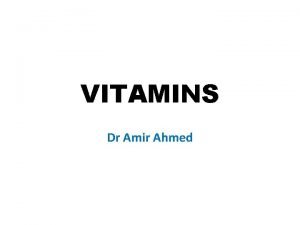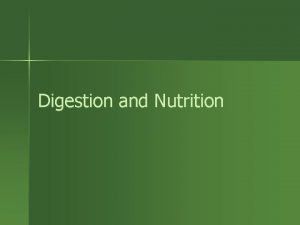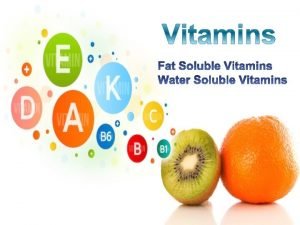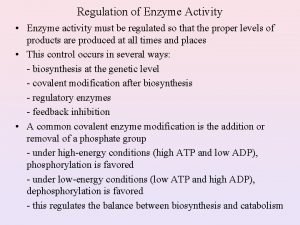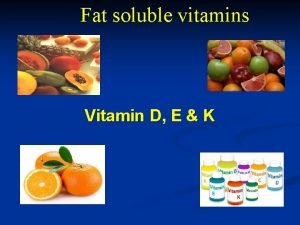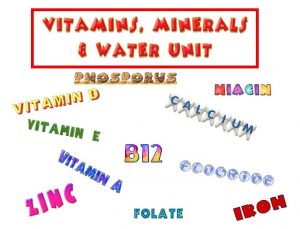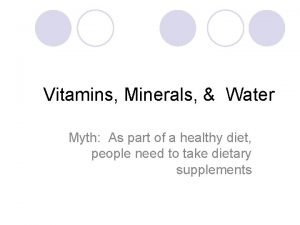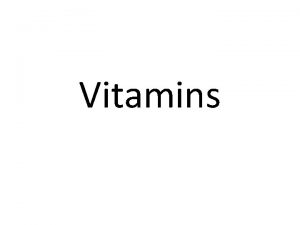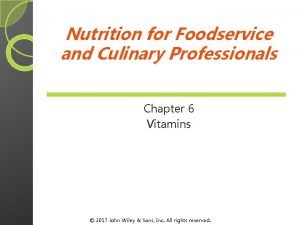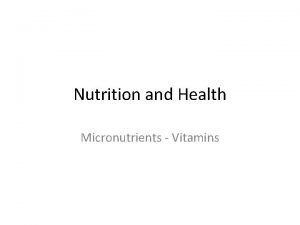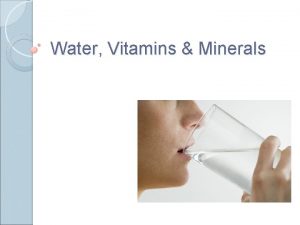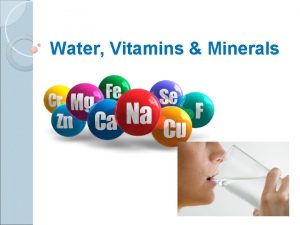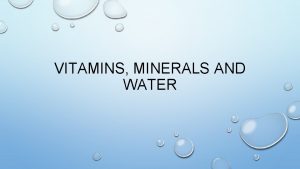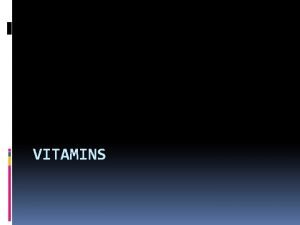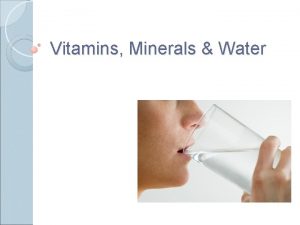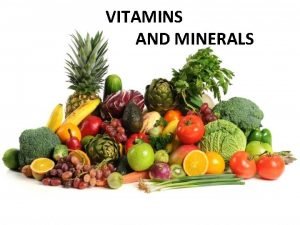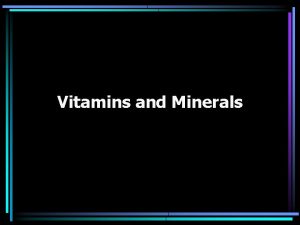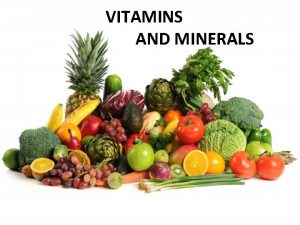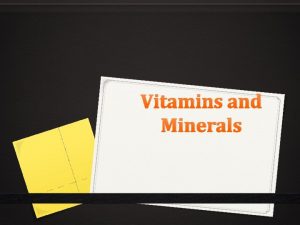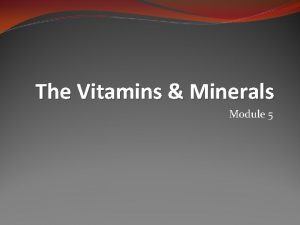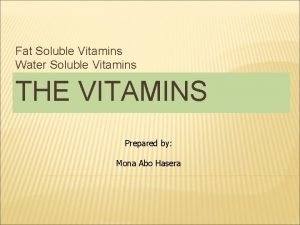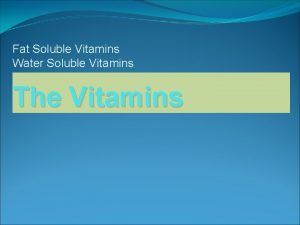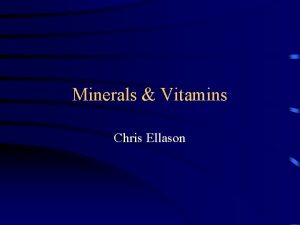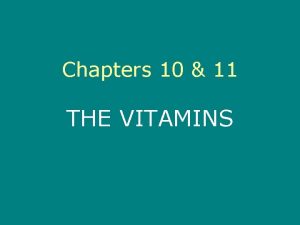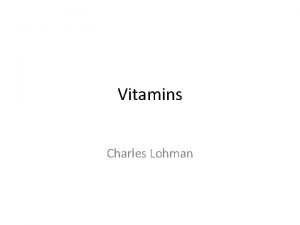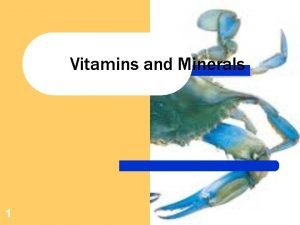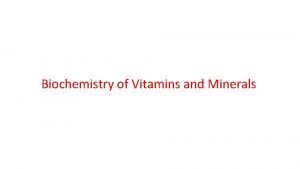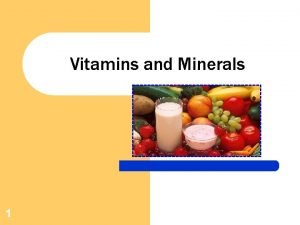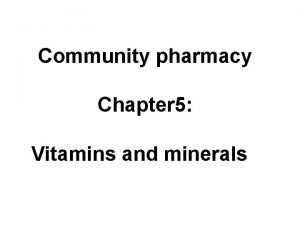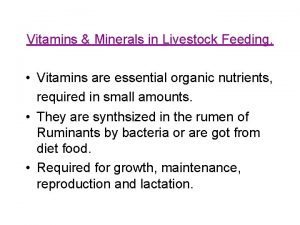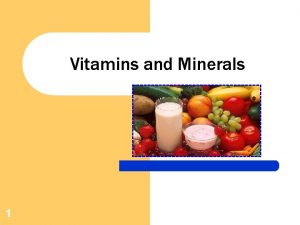Water Vitamins Minerals Intro to Water Vitamins Minerals





























- Slides: 29

Water, Vitamins, & Minerals

Intro to Water, Vitamins & Minerals 1. What is the main function of vitamins and minerals? To regulate body functions 2. What foods are many of the vitamins and minerals we need found in? Fruits and Vegetables

Intro to Water, Vitamins & Minerals 3. Because different fruits and vegetables have different vitamins and minerals, how can we ensure that we get all the different vitamins and minerals that we need? Eat a variety of fruits and vegetables 4. Which vegetables have the most vitamins and minerals? Red, Orange and Dark Green

Intro to Water, Vitamins & Minerals 5. How many calories are in Water, Vitamins and Minerals? ZERO! They may not provide any energy, but they are ESSENTIAL in keeping our bodies running! Quick Review of Nutrients: Nutrient Carbohydrates Fat Protein Calories Per Gram 4 9 4 Vitamins Minerals Water 0 0 0

Vocabulary 1. Deficiency: Not enough of something (shortage) 2. Toxicity: Too much of something (can become toxic/poisonous) 3. Water-Soluble: Dissolves in water 4. Fat-Soluble: Dissolves in fat 5. Macro: Large / Big amount 6. Micro or Trace: Small / Tiny amount 7. Electrolyte: Minerals that help maintain fluid balance in the body

WATER

Functions of Water 1. Functions of Water: a. Carries water soluble vitamins b. Regulated body temperature through perspiration c. Carries waste products through and out of the body d. Prevents dehydration 2. How much water should we drink every day? At least 8 cups a day (or 64 fl. oz. ) *Water is the MOST important nutrient our body needs! If you’re thirsty, you’re already dehydrated!

Dehydration 1. Dehydration happens when the water in your body drops below the level needed for normal body functions. 2. Common causes of dehydration: -Vomiting or diarrhea -Excessive urinating -Excessive sweating -Fever 3. Signs of dehydration: -Increased thirst -Dry mouth -Swollen tongue -Weakness -Dizziness -Confusion -Sluggishness -Fainting -Inability to sweat -Heart palpitations -Decreased urine output -Dark urine

Are YOU Hydrated? 1 2 3 4 5 6 7 8 If your urine matches the colors numbered 1, 2, or 3, you are HYDRATED! If your urine matches the colors numbered 4 to 8 you are DEHYDRATED and need to drink more fluid!! FYI: Hyponatremia is over-hydration. Balance in all things

Hydration Before, During and After Physical Fitness • For short duration (less than 60 min) water is a good choice to drink before, during and after exercise. • For moderate to high intensity activities (more than 60 min. ), sports drinks will help replace carbohydrate loss and electrolyte balance. • Drink according to thirst during the day and include fluids with meals. • Drink 8 -20 oz. of water an hour before exercise. • Continue drinking water during exercise, up to 16 -24 oz. of fluid per hour (4 -6 oz. every 15 min. ).

VITAMINS

Water-Soluble Vitamins Ascorbic Acid • Water-soluble means these vitamins dissolve in and are carried by water C Water-Soluble Vitamins B 9 Folate

Vitamin C (Ascorbic Acid) Function: Protects the body against infection Food Source: Citrus fruits, strawberries, broccoli and tomatoes Scurvy (Breakdown Deficiency: Toxicity: of collagen, bleeding gums and skin hemorrhages) Kidney stones, interferes with Vitamin E.

Scurvy Swollen and Bleeding Gums Spots on Skin

B 9 (Folate/Folic Acid) Function: Helps the body make new cells Food Source: Dark green leafy vegetables Spina Bifida Deficiency: (Neural tube defect that affects the spinal cord during fetal development) Toxicity: Masks B 12 Deficiency

Spina Bifida The spinal cord begins to develop within the first 28 days of pregnancy. Since folate makes new cells, it is vital that the mother’s body already has a supply of folate in her system to prevent this tragic condition.

Fat-Soluble Vitamins • Remember, fatsoluble means these vitamins dissolve in and are carried by fat • Remember KADE? . . . K A E D

Vitamin K Function: Food Source: Helps blood clot normally Dark green leafy vegetables (spinach, kale, collard greens, parsley, etc. ) Bleeding and Deficiency: Bruising Toxicity: Jaundice-breakage of red blood cells

Vitamin A Function: Promotes good vision, hair and skin Food Source: Red, orange and dark green vegetables Deficiency: Night Blindness Toxicity: Loss of appetite, blurred vision, joint pain

Vitamin D (“The Sunshine Vitamin”) Function: Builds and maintains bones and teeth Food Source: Milk/Dairy Products & Sunlight Deficiency: Rickets (Bowed Legs) Toxicity: Nausea and vomiting, kidney damage

Rickets

Vitamin E Function: Protects the membranes of white and red blood cells Vegetable Oils, Food Source: Fruits and Vegetables Deficiency: Poor nerve connection and neurological problems Toxicity: Headaches, brain hemorrhages, muscle weakness

MINERALS

Macro/Micro Minerals Macro. Minerals Calcium • Macro means you need a large amount of these minerals • Micro/Trace means you need a small amount of these minerals Micro/Trace. Minerals Iron

Calcium Function: Strengthens bones and teeth Food Source: Milk/Dairy Products, Whole Grains, Dark Green Leafy Vegetables Deficiency: Toxicity: Osteoporosis (Bones become weak and brittle due to mineral loss) -Kidney stones

Osteoporosis

Iron Function: Helps make red blood cells, helps our muscles store and use oxygen Food Source: Animal products, meat, dark green leafy vegetables Anemia Deficiency: (Low red blood cell formation) Toxicity: Heart disease, elevated LDLs

Electrolytes • Electrolytes helps maintain fluid balance in the body Electrolytes Sodium & Potassium

Sodium & Potassium Function: Maintains fluid balance in the body Food Source: Salt, fruits and vegetables Muscle cramps, Deficiency: irregular heart beat, seizures Toxicity: High blood pressure
 Water soluble vitamins vs fat soluble vitamins
Water soluble vitamins vs fat soluble vitamins Chapter 8 vitamins and minerals
Chapter 8 vitamins and minerals Carbohydrates in milk
Carbohydrates in milk Classify minerals
Classify minerals Classification of minerals
Classification of minerals Site:slidetodoc.com
Site:slidetodoc.com Water and water and water water
Water and water and water water Water soluble vitamins characteristics
Water soluble vitamins characteristics Water soluble vitamins characteristics
Water soluble vitamins characteristics Difference between fat soluble and water soluble vitamins
Difference between fat soluble and water soluble vitamins Water soluble vitamins adek
Water soluble vitamins adek Water soluble vitamins characteristics
Water soluble vitamins characteristics Water soluble vitamins
Water soluble vitamins Are vitamins tasteless
Are vitamins tasteless Vitamin d ergocalciferol
Vitamin d ergocalciferol Characteristics of water soluble vitamins
Characteristics of water soluble vitamins Characteristics of vitamins
Characteristics of vitamins Enzyme regulation
Enzyme regulation Vitamin d e k
Vitamin d e k Water soluble vitamins
Water soluble vitamins Water soluble vitamins chart
Water soluble vitamins chart Absorbs water and minerals
Absorbs water and minerals Minerals in water
Minerals in water Minerals sources functions and deficiency chart
Minerals sources functions and deficiency chart Vitamin classification chart
Vitamin classification chart Vital amines meaning
Vital amines meaning The chef does everything but cook that's what wives are for
The chef does everything but cook that's what wives are for Categories of vitamins
Categories of vitamins Orange vegetables list
Orange vegetables list Different forms of vitamin a
Different forms of vitamin a
